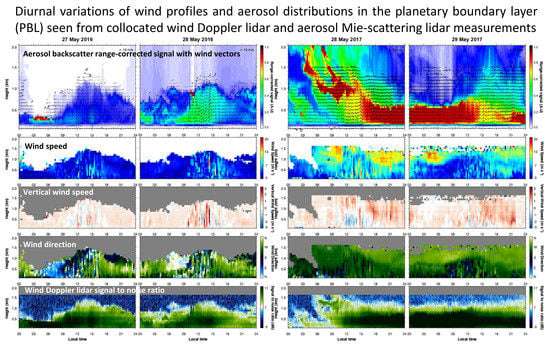Measurement of Planetary Boundary Layer Winds with Scanning Doppler Lidar
Abstract
:1. Introduction
2. Instrumentation and Measurements
2.1. Principle of the Wind Doppler Lidar
2.2. Wind Data Retrieval Processes
2.3. Measurements
3. Results and Discussion
3.1. Comparison of Wind Retrieval Processes
3.2. Diurnal Variation of Winds
4. Conclusions
Supplementary Materials
Author Contributions
Funding
Conflicts of Interest
References
- Reitebuch, O.; Strassburger, A.; Emeis, S.; Kuttler, W. Nocturnal secondary ozone concentration maxima analysed by sodar observations and surface measurements. Atmos. Environ. 2000, 34, 4315–4329. [Google Scholar] [CrossRef]
- Ouwersloot, H.; Vilà-Guerau de Arellano, J.; Nölscher, A.; Krol, M.; Ganzeveld, L.; Breitenberger, C.; Mammarella, I.; Williams, J.; Lelieveld, J. Characterization of a boreal convective boundary layer and its impact on atmospheric chemistry during HUMPPA-COPEC-2010. Atmos. Chem. Phys. 2012, 12, 9335–9353. [Google Scholar] [CrossRef] [Green Version]
- Baker, W.E.; Atlas, R.; Cardinali, C.; Clement, A.; Emmitt, G.D.; Gentry, B.M.; Hardesty, R.M.; Källén, E.; Kavaya, M.J.; Langland, R. Lidar-measured wind profiles: The missing link in the global observing system. Bull. Am. Meteorol. Soc. 2014, 95, 543–564. [Google Scholar] [CrossRef]
- Davies, F.; Middleton, D.; Bozier, K. Urban air pollution modelling and measurements of boundary layer height. Atmos. Environ. 2007, 41, 4040–4049. [Google Scholar] [CrossRef]
- Zhang, D.-L.; Zheng, W.-Z. Diurnal cycles of surface winds and temperatures as simulated by five boundary layer parameterizations. J. Appl. Meteorol. 2004, 43, 157–169. [Google Scholar] [CrossRef]
- Barlow, J.F.; Dunbar, T.M.; Nemitz, E.G.; Wood, C.R.; Gallagher, M.W.; Davies, F.; O’Connor, E.; Harrison, R.M. Boundary layer dynamics over London, UK, as observed using Doppler lidar during REPARTEE-II. Atmos. Chem. Phys. 2011, 11, 2111–2125. [Google Scholar] [CrossRef] [Green Version]
- Emeis, S.; Schäfer, K. Remote Sensing Methods to Investigate Boundary-layer Structures relevant to Air Pollution in Cities. Bound.-Lay. Meteorol. 2006, 121, 377–385. [Google Scholar] [CrossRef]
- Emeis, S.; Schäfer, K.; Münkel, C. Surface-based remote sensing of the mixing-layer height–A review. Meteorol. Z. 2008, 17, 621–630. [Google Scholar] [CrossRef] [PubMed]
- Strauch, R.G.; Merritt, D.A.; Moran, K.P.; Earnshaw, K.B.; Kamp, D.V.D. The Colorado Wind-Profiling Network. J. Atmos. Ocean. Technol. 1984, 1, 37–49. [Google Scholar] [CrossRef]
- Weitkamp, C. Lidar: Range-Resolved Optical Remote Sensing of the Atmosphere; Springer Science & Business: New York, NY, USA, 2006; Volume 102, ISBN 0387251014. [Google Scholar]
- Pearson, G.; Davies, F.; Collier, C. Remote sensing of the tropical rain forest boundary layer using pulsed Doppler lidar. Atmos. Chem. Phys. 2010, 10, 5891–5901. [Google Scholar] [CrossRef] [Green Version]
- Bingöl, F.; Mann, J.; Foussekis, D. Conically scanning lidar error in complex terrain. Meteorol. Z. 2009, 18, 189–195. [Google Scholar] [CrossRef]
- Päschke, E.; Leinweber, R.; Lehmann, V. An assessment of the performance of a 1.5 μm Doppler lidar for operational vertical wind profiling based on a 1-year trial. Atmos. Meas. Tech. 2015, 8, 2251–2266. [Google Scholar] [CrossRef] [Green Version]
- Sroga, J.T.; Eloranta, E.W.; Barber, T. Lidar Measurement of Wind Velocity Profiles in the Boundary Layer. J. Appl. Meteorol. (1962–1982) 1980, 19, 598–605. [Google Scholar] [CrossRef] [Green Version]
- Werner, C. Doppler Wind Lidar. In Lidar: Range-Resolved Optical Remote Sensing of the Atmosphere; Weitkamp, C., Ed.; Springer: New York, NY, USA, 2005; pp. 325–354. ISBN 978-0-387-25101-1. [Google Scholar]
- Browning, K.; Wexler, R. The determination of kinematic properties of a wind field using Doppler radar. J. Appl. Meteorol. 1968, 7, 105–113. [Google Scholar] [CrossRef]
- Kim, S.-W.; Berthier, S.; Raut, J.-C.; Chazette, P.; Dulac, F.; Yoon, S.-C. Validation of aerosol and cloud layer structures from the space-borne lidar CALIOP using a ground-based lidar in Seoul, Korea. Atmos. Chem. Phys. 2008, 8, 3705–3720. [Google Scholar] [CrossRef] [Green Version]
- Park, M.-S. Overview of Meteorological Surface Variables and Boundary-Layer Structures in the Seoul Metropolitan Area during the MAPS-Seoul Campaign. Aerosol Air Qual. Res. 2018, in press. [Google Scholar] [CrossRef]
- Pearson, G.; Davies, F.; Collier, C. An Analysis of the Performance of the UFAM Pulsed Doppler Lidar for Observing the Boundary Layer. J. Atmos. Ocean. Technol. 2009, 26, 240–250. [Google Scholar] [CrossRef]







| Wavelength | 1.55 μm |
|---|---|
| Pulse repetition rate | 16 kHz |
| Doppler velocity range | −30 m s−1–30 m s−1 |
| Range resolution | 30 m, 75 m, 150 m (user-defined) |
| Average power | 7 W (@ 75 m resolution) |
| Scanning Mode | Plan Position Indicator (PPI) |
|---|---|
| Sampling frequency | 16 kHz |
| Scanning speed | 1° s−1 |
| Range resolution | 75 m |
| Zenith angle | 80° |
| Azimuth angle | −90°–90° |
© 2018 by the authors. Licensee MDPI, Basel, Switzerland. This article is an open access article distributed under the terms and conditions of the Creative Commons Attribution (CC BY) license (http://creativecommons.org/licenses/by/4.0/).
Share and Cite
Park, S.; Kim, S.-W.; Park, M.-S.; Song, C.-K. Measurement of Planetary Boundary Layer Winds with Scanning Doppler Lidar. Remote Sens. 2018, 10, 1261. https://doi.org/10.3390/rs10081261
Park S, Kim S-W, Park M-S, Song C-K. Measurement of Planetary Boundary Layer Winds with Scanning Doppler Lidar. Remote Sensing. 2018; 10(8):1261. https://doi.org/10.3390/rs10081261
Chicago/Turabian StylePark, Soojin, Sang-Woo Kim, Moon-Soo Park, and Chang-Keun Song. 2018. "Measurement of Planetary Boundary Layer Winds with Scanning Doppler Lidar" Remote Sensing 10, no. 8: 1261. https://doi.org/10.3390/rs10081261
APA StylePark, S., Kim, S. -W., Park, M. -S., & Song, C. -K. (2018). Measurement of Planetary Boundary Layer Winds with Scanning Doppler Lidar. Remote Sensing, 10(8), 1261. https://doi.org/10.3390/rs10081261








